- Quick Read
- Deep Read ( 6 Min. )

Why is Christian Science in our name?
Our name is about honesty. The Monitor is owned by The Christian Science Church, and we’ve always been transparent about that.
The Church publishes the Monitor because it sees good journalism as vital to progress in the world. Since 1908, we’ve aimed “to injure no man, but to bless all mankind,” as our founder, Mary Baker Eddy, put it.
Here, you’ll find award-winning journalism not driven by commercial influences – a news organization that takes seriously its mission to uplift the world by seeking solutions and finding reasons for credible hope.
Explore values journalism About usMonitor Daily Podcast
- Follow us:
- Apple Podcasts
- Spotify
- RSS Feed
- Download
TODAY’S INTRO
Learning by leaps and rebounds
 Ira Porter
Ira Porter
From an open mezzanine above, I watched my daughter gaze excitedly at her teacher 30 feet away from her, standing behind a trampoline and a tumbling mat. Other little girls, dressed in similar colorful leotards, ran toward their instructor, then bounced and flipped.
Then it was my baby girl’s turn. And in the middle of summer, far from school halls, I’m seeing the power of another kind of learning.
She sprinted with her arms at her side – fast as lightning – bounced, did a front flip with her hands extended, rolled over, and hurried to get up. Her teacher told her to lie down, point her toes up, and stick her hands above her head. Mission completed, my beautiful 7-year-old looked up at me and smiled.
In a packed gymnasium at a Delaware Boys & Girls Club, I watched my son sneak up behind a boy dribbling a basketball at the top of the key and snatch it away. I jumped to my feet as he scooped the ball up off the hardwood and hurried toward his team’s basket. My wife was shouting next to me. A defender caught up to my soon-to-be 9-year-old boy, which made him stop temporarily, spin with the ball in his hand, lose his defender, and dribble straight toward the basket. I screamed, “Lay it up!” from the bleachers. He tried but clunked it too hard off the backboard. In that same game, he missed another shot and snatched two rebounds.
I have never been so excited over a gymnastics performance or a basketball game that wasn’t undertaken by a professional before. This has been a summer of learning for my babies. They are learning new sports: tennis, basketball, and gymnastics. Most importantly, they are having fun and learning to have the confidence that comes along with competing.
During the year, when I drive them to school in the morning, I drill them on what confidence means: to believe in oneself. I pray that they continue to get the lesson.
Share this article
Link copied.

Help fund Monitor journalism for $11/ month
Already a subscriber? Login

Monitor journalism changes lives because we open that too-small box that most people think they live in. We believe news can and should expand a sense of identity and possibility beyond narrow conventional expectations.
Our work isn't possible without your support.
How to tell if Trump indictments are ‘political’
Do recent indictments of Donald Trump reflect overdue legal accountability or unfair attacks by political rivals? The electorate is polarized, but some see ways to sift the difficult questions at play.
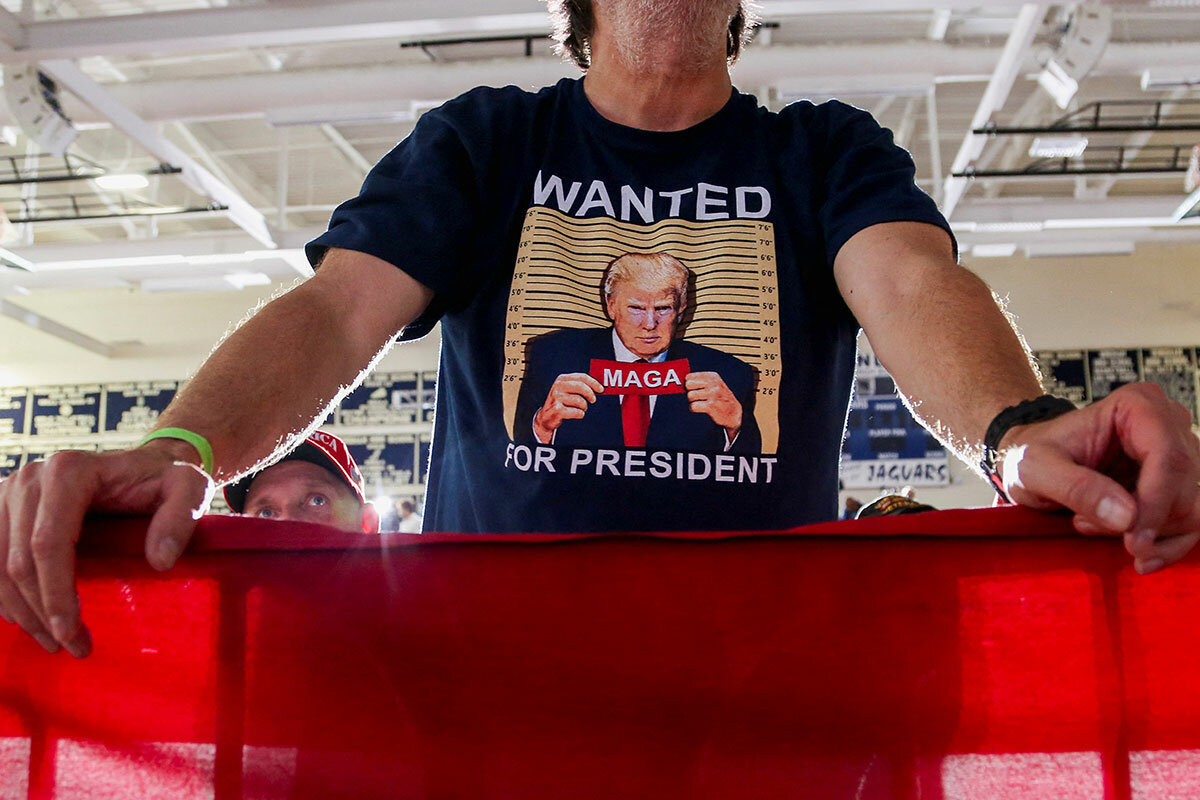
-
Patrik Jonsson Staff writer
-
Henry Gass Staff writer
If former President Donald Trump has a core defense against the indictments accumulating against him, it is that prosecutors are after him not for what he has done, but for who he is. He’s the faraway front-runner for the GOP nomination, and he’s the candidate Democrats fear most.
There is no easy way to sever political concerns from legal ones in the Trump cases.
It is true that President Joe Biden appointed the attorney general who appointed special counsel Jack Smith. Many state and local prosecutors in the United States are elected, including those behind lawsuits filed in New York and expected in Georgia against Mr. Trump.
To maintain faith in the American legal system, prosecutors in the Trump cases must be extra-vigilant to try to prove their actions are driven by the law, not by politics, say some experts.
Beyond potential influence on the 2024 elections, “the bigger concerns have to do with people’s faith in and trust in political institutions,” says political scientist William Howell. In 2024, “the stakes are big, and they’re much bigger than Trump’s own political fate and legal fate,” he says.
How to tell if Trump indictments are ‘political’
If former President Donald Trump has a core defense against the indictments accumulating against him, it is that prosecutors are after him not for what he has done, but for who he is.
Mr. Trump and his allies have long argued that the federal and state charges he now faces are a coordinated political effort to derail his 2024 presidential campaign. It’s obvious, he says – he’s the faraway front-runner for the GOP nomination, and he’s the candidate Democrats fear most.
“When you look at what’s happening, this is a persecution of a political opponent. This was never supposed to happen in America,” Mr. Trump said last week after pleading not guilty to four counts of attempting to overturn the 2020 vote.
Prosecutors and Trump opponents dismiss that framing as an attempt by the former president to evade accountability for past actions. He chose to run for the Oval Office again, announcing early in an effort to establish a political shield, they say. Mr. Trump is arguing in essence that he is above the law, his opposition says.
But the bottom line, say some legal experts, is that there is no easy way to sever political concerns from legal ones in the Trump cases.
It is true that President Joe Biden appointed the attorney general who appointed special counsel Jack Smith. Many state and local prosecutors in the United States are elected, including the Democratic Manhattan district attorney suing Mr. Trump on charges related to paying hush money to a porn star, and the Democratic Atlanta-area district attorney reportedly set to indict Mr. Trump on election charges next week.
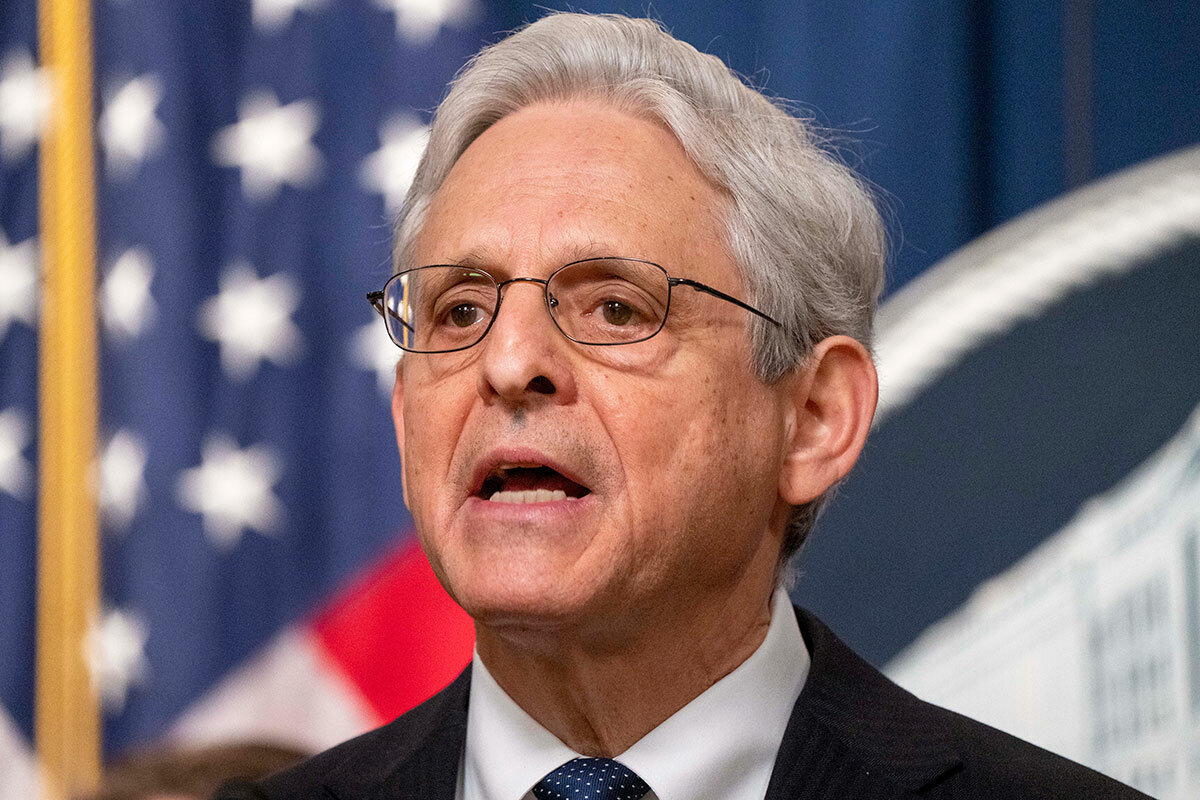
To maintain faith in the American legal system, prosecutors in the Trump cases must be extra-vigilant to try to prove their actions are driven by the law, not by politics, say some experts. The problem is that the nation faces a rocky road ahead as the Trump cases progress. Many voters in a polarized nation might judge not pursuing the former president as a political choice of sorts. Another large chunk might believe the opposite.
“Any kind of election crime is going to be inherently political,” says Anthony Michael Kreis, a law professor and political scientist at Georgia State University in Atlanta. “There are going to be political actors involved, political parties, candidates with partisan affiliation, so there are going to be those overtones present no matter what.”
Amid polarized reactions, any clarity?
Polls on perception of politics in the Trump indictments show a predictably divided American electorate.
An ABC News/Ipsos survey released last week found that 46% of respondents said yes when asked if the election charges brought against Mr. Trump by special counsel Smith were politically motivated. Forty percent said no and 14% said they did not know.
Overall, 51% of respondents said the election charges were “very serious” in the ABC survey (14% said they were “somewhat serious”). Results were highly skewed along partisan lines: Eighty-four percent of Democrats and 53% of independents said the charges were very serious, but only 19% of Republicans.
This split reflects the nature of the defendant in this case. He is not a mayor brought up on tax charges or a county supervisor’s wife charged with voter fraud intended to boost her husband. He is one of the most famous people in the nation – arguably in the world – who commands the loyalty of millions of voters and the rapt attention of thousands of journalists.
Mr. Trump has the power to amplify his objections to his situation far beyond that of typical targets of the Justice Department or local prosecutors. But that is not a reason to refrain from pursuing allegations against him, says Kristy Parker, counsel at the Washington nonprofit Protect Democracy and a former federal civil rights prosecutor.

“If we allow ourselves to have a system where if somebody is politically popular or has a large following and a capacity to try the case in the media, if we walk away from those sorts of people, that’s basically creating an immunity for our political class,” says Ms. Parker.
Last month Protect Democracy released what it terms a guide to determining whether the federal charges against Mr. Trump represent politicized justice or accountability. Boiled down, the guide asks three questions.
First, is there evidence suggesting political interference with the Justice Department investigation?
Second, is there evidence to support the indictment, and is Mr. Trump being treated as others in a similar situation would be?
Third, are courts and judges upholding Justice Department actions?
The analysis argues that all these criteria have been met – that President Biden has insulated himself from the federal cases, the cases are solid, and the legal system is working.
“Based on what we currently know, the answers to these key questions support the conclusion that an independent Justice Department is properly seeking to hold Trump accountable,” says Protect Democracy in its guide.
One risk: a cycle of retaliation
Mr. Trump and his supporters would vehemently disagree with that conclusion. The former president has long lumped in the legal investigations of his actions with the Russia investigation and his impeachments as a connected string of “witch hunts” directed by his political opponents.
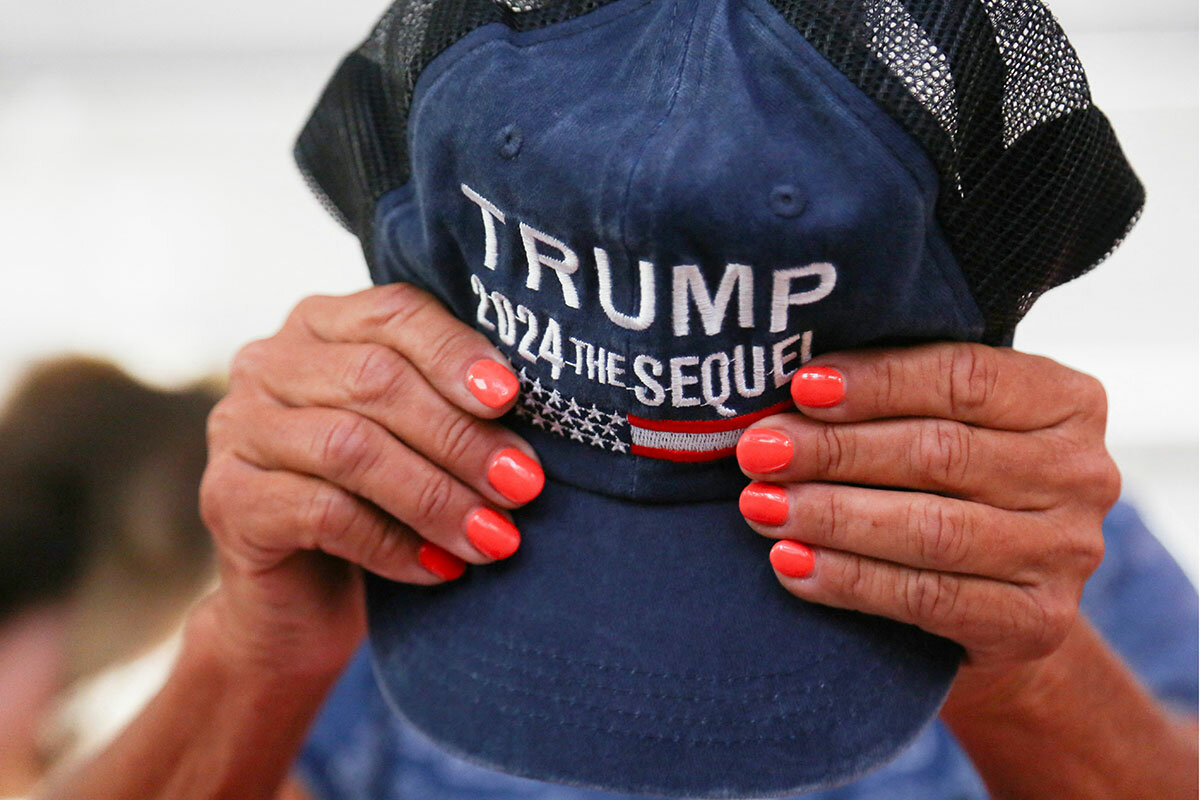
President Biden in fact keeps a close eye on the Trump legal proceedings and is ultimately responsible for their beginning, say Trump supporters. In a legal filing last week, the Trump legal team charged that an image of the president holding a “Dark Brandon” mug, posted on social media, was an oblique comment on Mr. Trump’s federal indictments.
The First Amendment and the Electoral Count Act will ultimately derail the prosecutions, says Mike Davis, a lawyer and president of the Article III Project, a Washington judicial nonprofit. He says that President Biden greenlighted the “lawfare” against his likely GOP opponent and is very much behind it.
“This is unprecedented, and highly destructive to the American democracy that Democrats are pretending to protect,” Mr. Davis says.
In a way, the damage may already have been done, he adds.
“There’s no going back now. There is no chance that Republicans are not going to retaliate,” Mr. Davis says.
That echoes the fears of many Trump opponents – that a cycle of political retaliation could swirl out of the current prosecutions. If Mr. Trump wins in 2024, he could attempt to pardon himself, or derail ongoing cases against him. Then he could break through the guardrails that are intended to separate the Justice Department from the White House and personally direct U.S. law enforcement decisions.
Currently the Trump indictments appear likely to help the former president solidify his grip on the GOP presidential nomination. Their effect on a general election is less obvious, but could well depress his vote, according to current polling.
“The bigger concerns have to do with people’s faith in and trust in political institutions,” says William Howell, a political science professor and director of the Center for Effective Government at the University of Chicago.
Whoever wins the next presidential election, a large slice of the electorate may see the outcome as a crushing loss and reflective of decay in the American political system. Mr. Trump’s hold on the GOP might tighten further – or fall apart. The health of American democracy might appear to be in question.
In 2024, “the stakes are big, and they’re much bigger than Trump’s own political fate and legal fate,” says Professor Howell.

Women make South Sudan safe, one explosion at a time
Often left disenfranchised and widowed by back-to-back wars, women in South Sudan have placed themselves on the front lines of a different kind of battle: clearing the country’s huge amount of unexploded munitions.
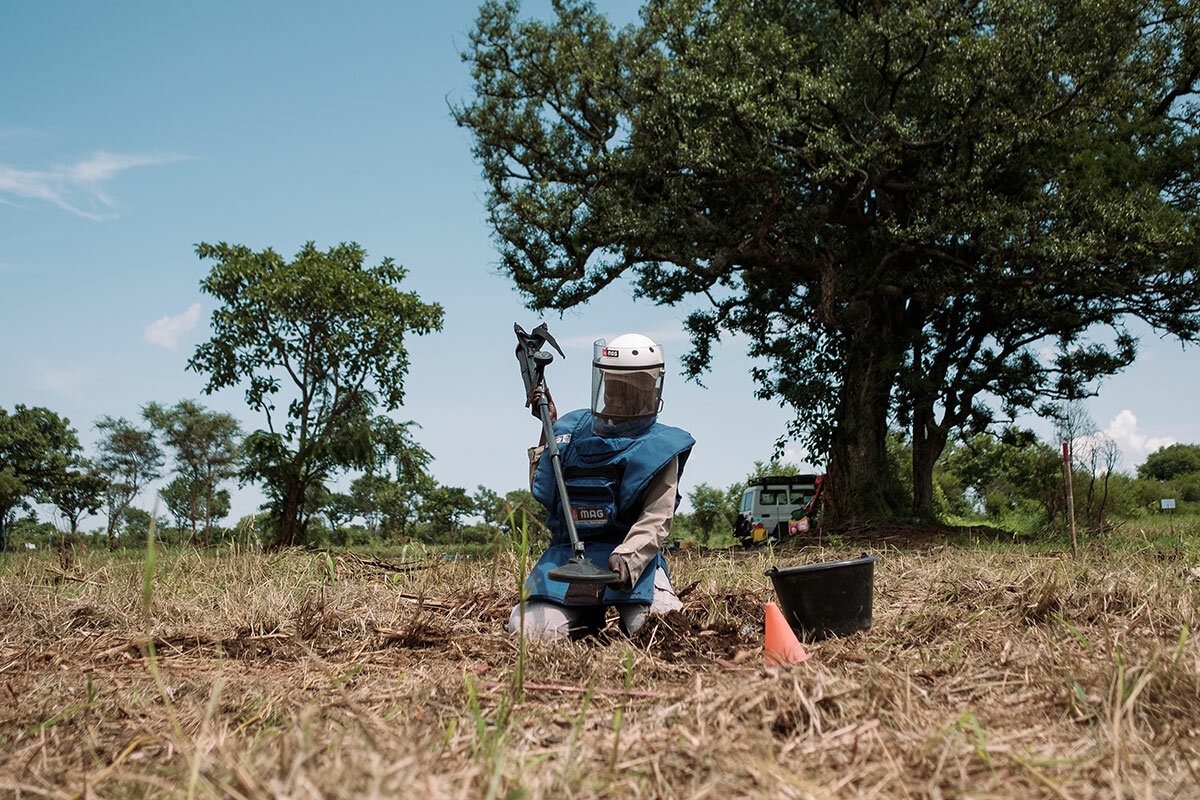
- Quick Read
- Deep Read ( 6 Min. )
-
By Sira Thierij Contributor
Monica Achol focuses on the abandoned field, tightly gripping a detonator whose wire snakes away 200 meters. When a colleague utters the word “Fire!” Ms. Achol presses a button with both her thumbs.
A long-forgotten cluster munition detonates, and the team sighs in relief. That’s one fewer bomb in South Sudan, their home.
Twelve years after the country gained independence, poverty, ethnic rivalries, and tensions over resources are buffeting South Sudan. Explosive remnants of war – which have killed or injured more than 5,000 people in the last decade – are still scattered over 500 million square feet.
Ms. Achol and her colleagues are at the forefront of the fight to remove them all. “We’re saving the lives of our people,” she says while clearing up the site of the explosion.
Women overwhelmingly do this work. They are more deliberate and cause fewer accidents than men do, mine experts say. But there’s a dire reality, too. Many men have died on the front lines while fighting for their country’s independence and during the civil wars, leaving behind thousands of single women to tend to their families.
“I give my people freedom to work, to cultivate their land and grow food, so more can return home” safely, Ms. Achol says.
Women make South Sudan safe, one explosion at a time
Monica Achol holds her breath as she crouches on the dry grass under the protective cover of a tree. She focuses on the field ahead, her fine, red-colored dreads tied back into a high ponytail. A metallic cable snakes from a detonator she is gripping tightly, across the dusty ground, to a target 200 meters (about 650 feet) away.
“All clear!” her colleague, Antasia Bullen, shouts through a walkie-talkie.
Ms. Bullen counts to three. When she utters the word “Fire!” Ms. Achol presses the round button with both her thumbs.
The explosion lifts the surrounding soil and sandbags, sending fragments of metal flying in all directions. Even from the distance where Ms. Achol is crouched, the ground shakes.
Only then do the team members breathe a sigh of relief. They have witnessed hundreds of explosions like this, but now there’s one fewer bomb in South Sudan, their home.
Thousands more are still buried in fields across the world’s youngest country, one of the most heavily contaminated with mines and bombs. Ms. Achol and her colleagues are at the forefront of the fight to remove them all. “We’re saving the lives of our people,” she says later, while clearing up the site of the explosion.
South Sudan has been in turmoil for most of its existence. It fought for decades to gain independence from neighboring Sudan in Africa’s longest-lasting civil war. In 2011, the new republic was formed, but peace didn’t hold. Two years later, another civil war broke out along ethnic lines, killing nearly 400,000 people and displacing millions.
Explosive remnants of war – which have killed or injured more than 5,000 people in the last decade – are still scattered over 500 million square feet, according to the United Nations Mine Action Service.
And after 12 years of independence, extreme poverty, ethnic rivalries, and tensions over resources – all stoked by the climate emergency – continue to roil the vast desert nation. Conflict that broke out in neighboring Sudan in April has so far brought over 130,000 returnees, adding yet another emergency to an already challenging situation.
Amid this reality, deminers like Ms. Achol focus on the future, making their country safer one controlled mine explosion at a time. “I give my people freedom to work, to cultivate their land and grow food, so more can return home” safely, she says.
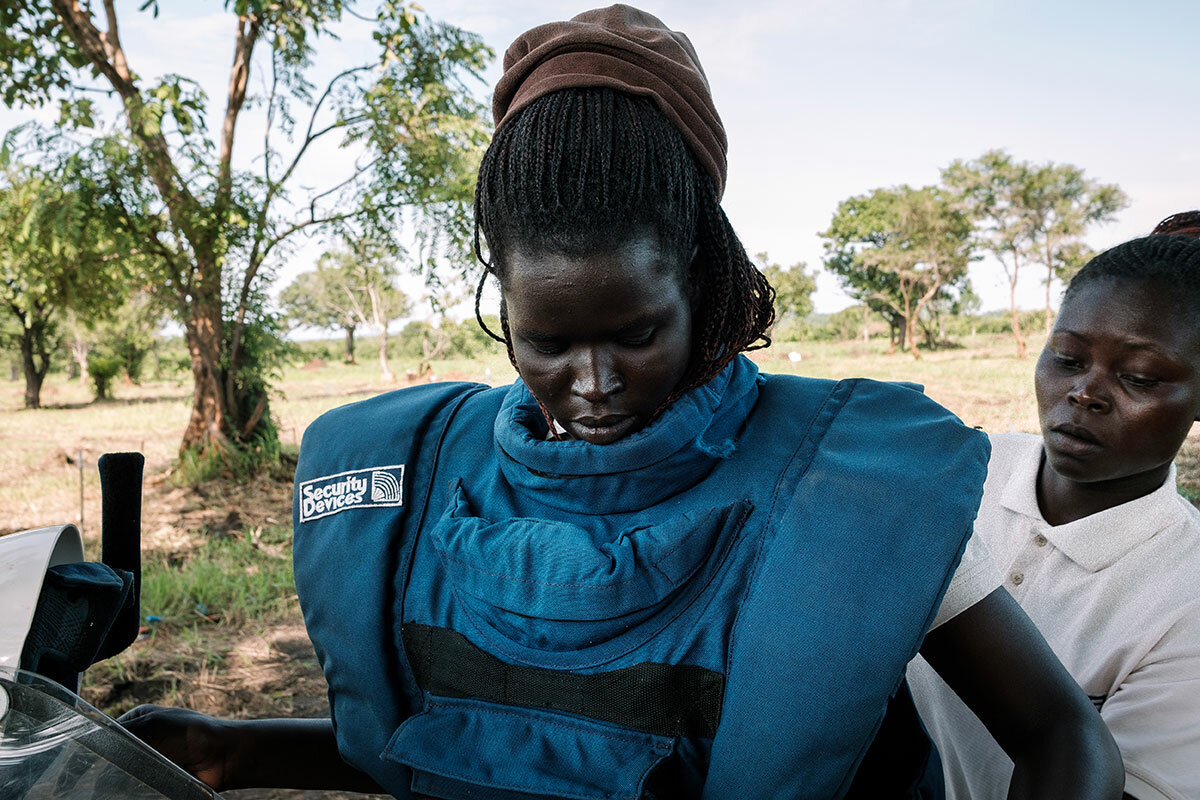
Women in charge
A fast talker with a warm smile, the young mother became a deminer for the international nongovernmental organization Mines Advisory Group in 2018. She’s out in the field six days a week, while her daughter stays with family in the capital, Juba. Ms. Achol says she wants to give back to the communities she grew up in and provide a safer future for her child.
In South Sudan, it is overwhelmingly women who are clearing their country of unexploded ordnance. They are more deliberate with their work, follow protocols, and cause fewer accidents than men do, mine experts say. But there’s a dire reality, too. Many men have died on the front lines while fighting for their country’s independence and during the civil wars, leaving behind thousands of single women to tend to their families.
In Ms. Achol’s demining group of 10, seven are women.
“In Africa, the family is traditionally headed by the man, but not in South Sudan,” where a lot of families are headed by women, says Anna Tazita Samuel, the director of Women for Change, a local nonprofit based in Juba. “Not because they wish so, but because of the situation. They always think beyond what’s in front of them.”
On a recent afternoon, another demining team arrived at a primary school in Ayii, in the southernmost part of the country, to spread awareness amongst South Sudan’s next generation.
Around a hundred new children have recently returned from refugee camps in neighboring Uganda, where they stayed for years to keep safe from the civil wars that started in 2013. But around October last year, some families began receiving only half of their monthly food assistance as foreign governments slashed spending on international humanitarian aid. That pushed many to return home.
In the school’s courtyard, Clara Haas points to a poster with colorful illustrations of bombs and land mines. She’s a risk educator and travels the country to warn about the dangerous devices. “When they are underground, they may stay for years, but they don’t expire, OK? They will only expire when you step on them. Then they explode,” she says.
Sitting on cramped wooden benches, some children rest their arms and heads on the table after a long school day. Others whisper answers in their neighbor’s ear, too shy to speak up in front of everyone when Ms. Haas asks a question.
But there’s a harsh reality to this lesson. For these learners, it’s not just a lecture about abstract threats – they quickly recognize one of the perilous objects as being identical to one sitting in the school’s backyard.
After the lesson, the risk educators walk with the teacher through thick, high grass behind the classroom, passing barracks and run-down buildings wrecked by years of war. And there it is, in the corner of what used to be the students’ restroom: a rusty, cone-shaped bomb, too dangerous even for the visiting team to move. They call a fully-equipped team of colleagues working nearby to destroy the munition before a child picks it up.
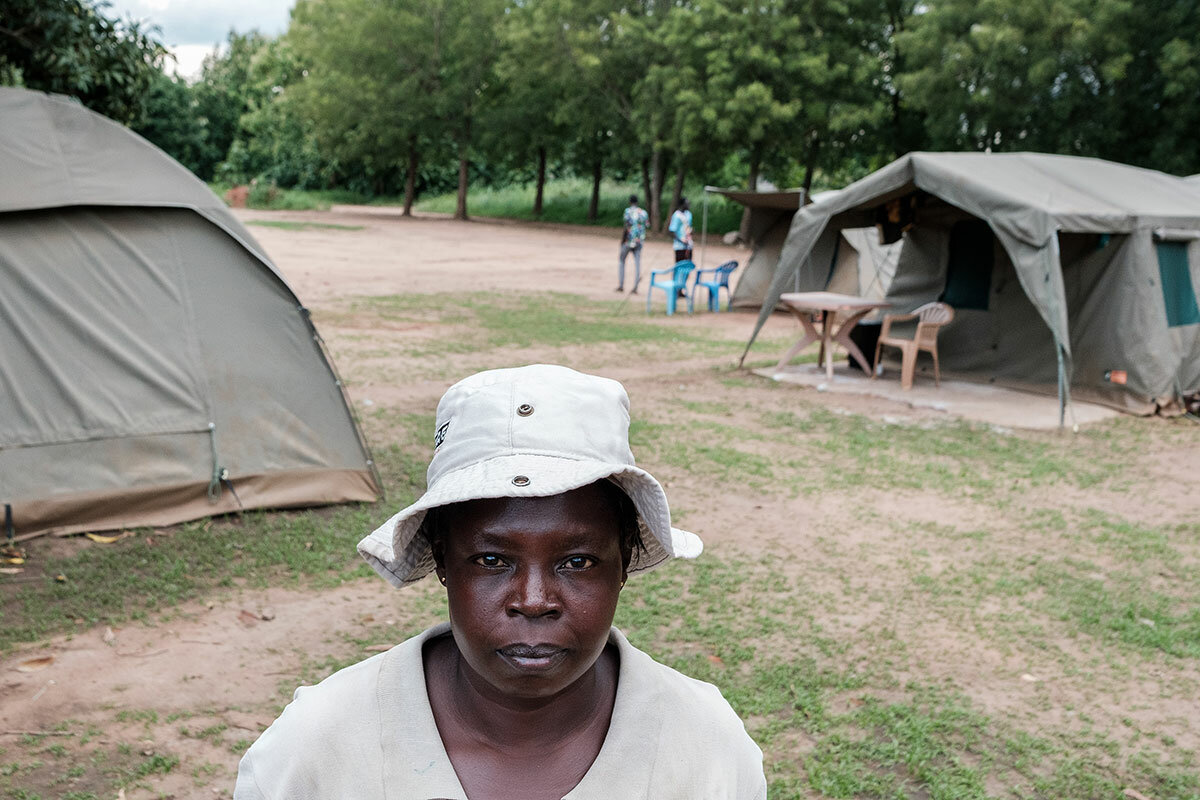
Hoping for freedom
On farmland close to the school, Loice Nyoka takes one heedful step after another. Her heavy boots barely touch the sand as she combs through the ground. A farmer has called the team of deminers to examine his land.
Ms. Nyoka was a young girl when she saw her neighbor step on a land mine and lose his limbs in a small village nearby. The young mother grew up during back-to-back wars and spent a childhood on the move, fleeing her home and returning, a story she shares with millions of other South Sudanese. Once, she ran into gunmen on her way to find food. Then they came and raped her aunt, she says.
In 2017, when fighting worsened, she moved her family to neighboring Uganda to keep them safe. There, relatives take care of her 2-year-old son Elian, while Ms. Nyoka clears their land back home.
“I pray that these ups and downs end with me, that the same thing won’t happen to my child. The young kids, they should live, get freedom,” she says.
South Sudan hopes to remove all anti-personnel mines and cluster munitions by 2026. An ambitious but unlikely goal, experts say, as workers like Ms. Nyoka discover explosive devices every day across the country.
Tak, tak, tak, tak. The rhythmic sounds of her metal detector accompany each step. Then a high-pitched beep rings out: Danger lurks underground.
Ms. Nyoka’s colleague, Ms. Achol, rushes to the scene. Wearing white helmets with oversize visors and thick bulletproof vests, the women dig up the soil: yet another bomb, buried only a few inches underground. Within the next few weeks, they’ll destroy 40 more cluster munitions like this one.
Meanwhile, thousands of South Sudanese are crowded in refugee camps, waiting to return to their motherland once it’s safe enough to do so. One day, when the country calms down, Ms. Nyoka says she will bring her son Elian home from Uganda and show him all the land she and her colleagues made safe.
“I’ll then be proud to have raised a son in my own community where he learns about his country and his culture,” she says.

The women who run drug cartels
Another story about women in perhaps unexpected roles: A new book explores organized crime and finds women working behind the scenes, and at the top, of the Latin American drug trade.

- Quick Read
- Deep Read ( 5 Min. )
From Al Capone to Pablo Escobar, organized crime and the men in charge of running it have long been subjects of public fascination. But what is lost when our view of such a far-reaching phenomenon as drug trafficking is narrowly focused to include only men?
A new book by Mexico-based journalist Deborah Bonello looks at the women behind the scenes – and at the top – of the Latin American drug trade. She finds them in all kinds of unexpected and influential places.
Her research has been “a massive eye-opener,” she says, but law enforcement has not paid much attention to women in the drug business, allowing them to operate under the radar. This, says Ms. Bonello, “reflects the assumptions and the gender tropes that are going through the minds of people working on these cases.”
The author does not admire the subjects of her book but says she respects them for making their way in a male-dominated business in highly macho Latin American societies.
“If women are in the kitchen and these things are being discussed,” Ms. Bonello says she was once told, “they’re not just standing there stirring the sauce.”
The women who run drug cartels

From Al Capone to Pablo Escobar, organized crime and the men in charge of running it have long been subjects of public fascination. But what is lost when our view of such a far-reaching phenomenon as drug trafficking is narrowly focused to include only men? “Narcas: The Secret Rise of Women in Latin America’s Cartels,” a new book by Mexico-based journalist Deborah Bonello, digs into that question. She looks at the role of women behind the scenes – and at the top – in the Latin American drug trade, and why their stories matter. She recently spoke with the Monitor’s Whitney Eulich.
Why did you decide to write this book?
As a reporter who has covered organized crime since I got [to Mexico] in 2006, I always felt outnumbered by the men around me documenting organized crime. And they just didn’t seem to see the women [in the story]. Or, if they did, they were dismissed or minimized by their sexual or familial relationships to men.
Elaine Carey [a scholar on women in the drug trade] put it best when she said to me once, “If women are in the kitchen and these things are being discussed, they’re not just standing there stirring the sauce.” Women are involved in the way decisions are made; they have a huge amount of control over the men and women around them.
I wanted to see what I would find if I focused on the women. So, it sort of started off as an experiment, trying to apply a much more nuanced understanding of power. But then the more I looked, the more I found these very high-profile, high-ranking women. And then it just became a major obsession.
What were some of the challenges?
The book was definitely a tightrope-wire walk. I wanted to profile these women ... who are very high profile in traditionally male roles, and show that they are more than just girlfriends and wives. But I also had to be very careful, because they aren’t [U.S. soccer star] Megan Rapinoe or [tech executive] Sheryl Sandberg, so you can’t celebrate them in the same way. They are working for viscerally violent organizations that are a major threat to public security and public health.
Does including women in this narrative change how we should be approaching policies on the drug trade?
I do hope that the book will be read by prosecutors and lawyers and people who work in the DEA [Drug Enforcement Administration] and FBI and just shake up their thinking a little in the way they approach the drug trade, both in terms of penalties and incarceration but also in terms of the root causes driving people into it.
The way current drug-related policies are implemented in Latin America is flawed. The majority of women who are in prisons are there for low-level trafficking offenses. We’ve seen the female prison population in Latin America surge enormously over the last couple of decades. Prosecutors and defense lawyers told me that women take advantage of the fact that they are women and might go under the radar, which I can only think reflects the assumptions and the gender tropes that are going through the minds of people working on these cases. It’s flawed.
Meanwhile, Bonnie Klapper, who is a prominent criminal lawyer, said to me once, if there’s a female Chapo [Joaquín “El Chapo” Guzmán, former head of Mexico’s Sinaloa cartel currently in a maximum security prison in the United States] out there, then no one is looking for her. The common assumption is that there wouldn’t be one. And you find what you’re looking for, you know? And for a long time, we just haven’t been paying attention to women.
Violence isn’t the only lens for power. If you look at organized crime from a logistics standpoint, if you go after the money, you go after the transportation networks, increasingly women are operating in these areas. Chapo’s chief money launderer was a woman. When you look at it more holistically, the role of women is strong. It’s just much more nuanced than who is pulling the trigger or sending someone to pull the trigger. I think we’ve been blinded by our gender expectations of women.
What surprised you?
A really interesting part of the story for me was the different types of power that women see available to them. Across Latin America, it’s difficult for women ... with high levels of femicide and just general contempt for women who overstep any kind of traditional boundaries set out for them. I think power motivates us all in some way. I get it. I just don’t think women in this region have as many options.
Some of the women I met had law degrees. They had business experience. They’d started their own businesses. And clearly at some point, the drug trade just seemed like the best option. An ex-DEA guy told me that Central America’s most prolific drug trafficker – had she gone to work for a legit company, she’d be on the Forbes 500 list right now. It’s a lot of the same skills, dealing with logistics and relationships.
I’m curious to see what the feminist response will be to this book. I think one of the things that I really wanted to emphasize is that women do have agency and are making decisions every step of the way. This idea that women in the drug trade are just mules who are obliged to do it or women who tolerate what their husbands do – I just feel like that’s not a realistic perception of how things shake out. There’s a point where there’s always a limit on how many choices you have, but you are making them.
Is this book meant to be empowering or generate admiration?
I’ve never doubted [women’s] capacity to run a business or win a football game. So, why would I ever have underestimated us in this sense? It’s been a massive eye-opener.
I can’t say I admire these women, but I respect them. I think to make it, to make your way up in a powerful, male-dominated organization, is no small thing. I am in awe of their ability to work their way up while managing to stay so far off the radar of the anti-narcotics people. I do respect their achievements in the context of that world, but I can’t condone the actions of their organizations.

Essay
When a knickknack turned out to be precious art
When the true value of a piece of family art is discovered, our writer learns that the memories of shared experiences with family are priceless.

- Quick Read
- Deep Read ( 4 Min. )
-
By Elizabeth Neumann Fuller Contributor
We Fullers are not art connoisseurs. The least so was my late father-in-law, who, ironically, landed a job at an art college. The artistic highlight of Papa’s job was the annual holiday gift he received.
Like Opal. At 10 inches tall, she had an oversize smile and long-lashed eyes. Papa didn’t know what to make of Opal. He decided to raffle her off to a family member and devise a new competition to pass her on each year.
My son Brady won Opal that first year, followed by cousin Caleb in a tense pick-up-sticks game. Opal then traveled home with the winner of a table tennis tournament, a rock-paper-scissors duel, and a croquet match.
In 2005, we got a shock. Papa saw a photo of Opal in The New York Times. She was designed by Takashi Murakami, a popular artist. One sold at auction for thousands of dollars. We felt like philistines.
We bantered about how to spend the money if we sold her. A holiday cruise, perhaps?
But Opal was part of the family now. I see Papa in her winking eye. I see family tradition, spirited competition, and love. I think it’s fair to say we Fullers have become art aficionados.
When a knickknack turned out to be precious art

We Fullers are not a family of art connoisseurs. The least so was my late father-in-law, who, ironically, landed a job at an art college. Back in the 1980s, Papa – as we called him – transitioned from a long banking career to the director of finance for California Institute of the Arts.
Papa kept CalArts in the black by day, and at night he livened up the family dinner table with anecdotes about his new work environment. There was the student who took a plate from the cafeteria, put an apple and a banana on it, and balanced it on a post in the school parking lot for his senior project. And who can forget the young man who accepted his diploma in the altogether?
The artistic highlight of Papa’s job was the annual holiday gift he received from software entrepreneur and philanthropist Peter Norton. In 1988, Mr. Norton started a tradition of commissioning a contemporary artist to create an original, limited-edition work to give to a few thousand friends and members of the art world each holiday season. Mr. Norton was on the CalArts board, and Papa made the gift list – talk about fodder for Fuller dinner conversations!
Each year’s piece was given a place of honor on the dining room table during the holidays: a distorted and chipped teacup, a plate with an image of Medusa rendered in marinara sauce, and mini snow globes disguised as salt and pepper shakers. The fake shakers made for a fun practical joke as we passed them to unsuspecting dinner guests.
The best of these gifts was Opal. At about 10 inches tall, with a head that’s a white plastic sphere, she has an oversize smile and long-lashed eyes. She has small rubber limbs and sits upon another sphere decorated with smiling daisies. The bottom sphere holds a mini CD that plays electronic music. Papa didn’t know what to make of Opal. He decided it would be funny to raffle her off to a family member. We threw numbers in a hat, and he pulled out a winner. He stipulated that the winner must bring Opal back the next Christmas and devise a new competition to pass her on.
My 6-year-old son, Brady, won Opal that first year. He displayed her proudly on his bedroom bookshelf, next to his Thomas the Tank Engine coin bank. The following Christmas, we drove Opal back to Los Angeles, where cousin Caleb won her in a tense pick-up-sticks game. We may have laughed at Opal’s appearance, but we are a competitive lot. Everyone was keen to win.
It went on this way for several years. Opal traveled home with the winner of a table tennis tournament, a rock-paper-scissors duel, and an epic croquet match.
Then in 2005, we got a shock. Papa saw a photo of Opal in The New York Times. The article was about Mr. Norton’s holiday gifts and said that Opal (who was actually named Oval) was designed by Takashi Murakami, a highly popular and successful artist. An Oval from the batch that had been produced as Norton gifts was sold at auction for $7,500. We felt like philistines.
Cousin Eli had Opal that year. Before bringing her to LA for Christmas, he crocheted her a protective hat and packed her in a padded case. We all examined her carefully and with relief declared that she was still in mint condition. We bantered about how to spend the money she would fetch if we sold her. A holiday cruise, perhaps? But the article, alas, had warned that selling would get you crossed off Mr. Norton’s gift list. And anyway, Opal was part of the family now. She was lovingly passed along in a poker game that year, and then by a four square tournament and a blindfolded Jelly Belly taste test on subsequent holidays.
Years later, the young children in our family have grown up. Some are married and have children of their own. Papa passed away. I recently looked up that old New York Times article and read that – according to project overseer Kris Karamitsu – Mr. Norton had endeavored with his holiday gifts “to make contemporary art accessible and understandable, through an actual object that people can live with,” according to Mr. Murakami.
We have lived well with Opal. She sits now on my daughter’s dresser. When I glance Opal’s way, I see Papa in her winking eye and smiling daisies. I see family tradition, spirited competition, and love. I think it’s fair to say we Fullers have become art aficionados.
Other headline stories we’re watching
(Get live updates throughout the day.)The Monitor's View
In Ohio, civic bridges over cultural divides
- Quick Read
- Deep Read ( 3 Min. )
-
By the Monitor's Editorial Board
Since the U.S. Supreme Court rescinded constitutional protection of abortion a year ago, every state ballot measure affirming the right of women to make their own reproductive decisions has passed. Those states now include Ohio. Voters there rejected a proposal last night intended to make it harder to enshrine social issues like abortion in the state’s constitution.
One consequence of the court’s decision to return the question of abortion rights to “the people and their elected representatives” is now becoming more apparent. The voting trend on ballot initiatives, consistent across red and blue states, shows that one of the most polarizing cultural issues in American society is now uniting Americans in defense of democracy.
“Ohio is stronger when we can all lend our voices and we all have an equal chance to participate in the work of our state’s democracy,” said former Republican Gov. John Kasich.
By linking reproductive rights with democratic concerns, citizen-led ballot initiatives are creating openings for empathy and humility, acknowledging the inherent dignity and rights of all individuals.
Placed in the care of ordinary citizens, the divides over reproductive rights are finding new bridges. That progress involves listening even more than persuading.
In Ohio, civic bridges over cultural divides
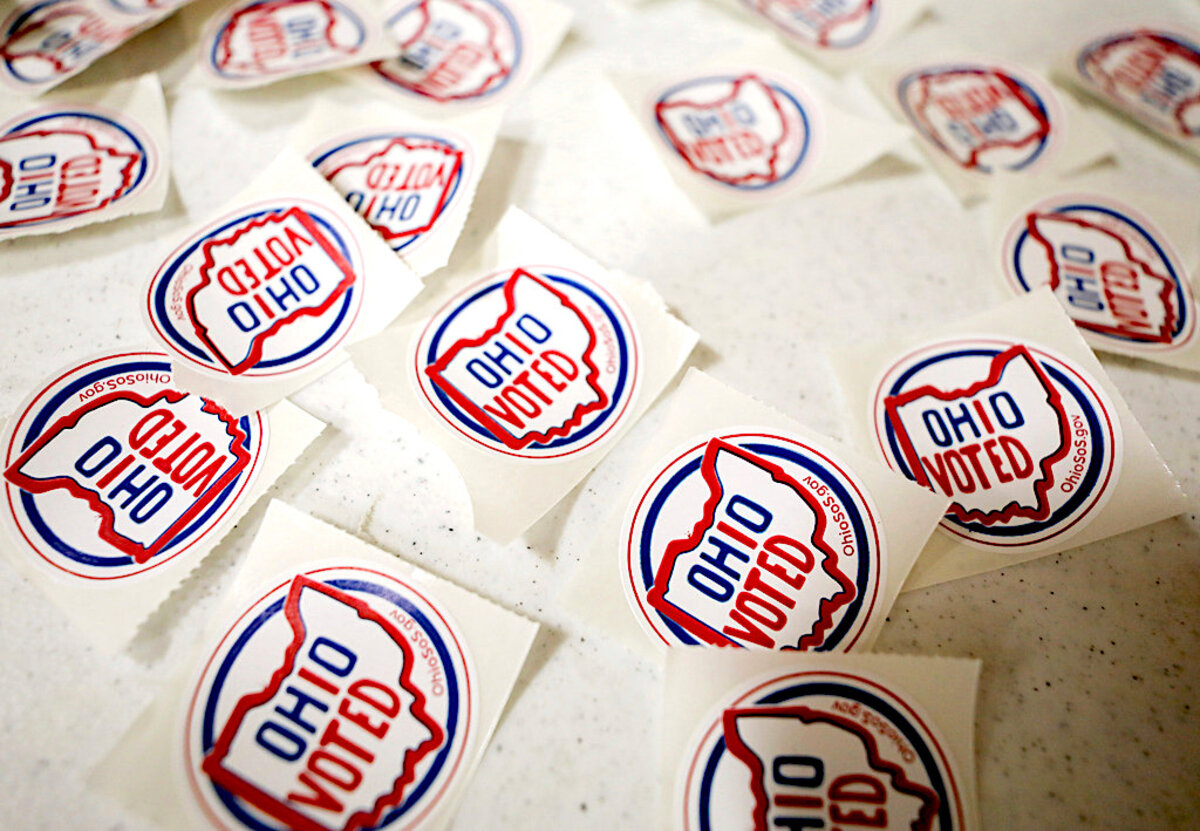
Since the U.S. Supreme Court rescinded constitutional protection of abortion a year ago, every state ballot measure affirming the right of women to make their own reproductive decisions has passed. Those states now include Ohio. Voters there rejected a proposal last night intended to make it harder to enshrine social issues like abortion in the state’s constitution.
One consequence of the court’s decision to return the question of abortion rights to “the people and their elected representatives” is now becoming more apparent. The voting trend on ballot initiatives, consistent across red and blue states, shows that one of the most polarizing cultural issues in American society is now uniting Americans in defense of democracy.
“Ohio is stronger when we can all lend our voices and we all have an equal chance to participate in the work of our state’s democracy,” said former Republican Gov. John Kasich, one member of a bipartisan group of past Ohio governors and attorneys general who opposed the ballot measure.
Kansas was the first to signal this trend. Two months after the court’s reversal, which came in Dobbs v. Jackson Women’s Health Organization, voters rejected a proposal that would have denied a right to abortion in the state’s constitution. Tens of thousands of Republicans joined in voting no. Since then, other states such as Kentucky and Michigan have done the same.
By linking reproductive rights with democratic concerns, citizen-led ballot initiatives are creating openings for empathy and humility, acknowledging the inherent dignity and rights of all individuals. In Kansas, for example, “the people that we talked to really didn’t see abortion as a partisan or political issue,” Ashley All, communications director for Kansans for Constitutional Freedom, told Kansas Reflector after the state’s abortion vote. “They saw it as incredibly complex and deeply personal, and so we intentionally approached it in a nonpartisan way.”
Proponents of the Ohio proposal admitted their motives were tactical. The measure would have raised the threshold for changing the state constitution from 50% plus one vote to 60%. Had it passed, it would have made it harder to approve a proposed amendment upholding a state right to abortion in a referendum this November.
The state’s Republican election officials admitted hoping that an August ballot would draw low voter turnout. They were wrong. Nearly 650,000 cast early ballots, more than in recent primary elections. In the end, 57% of voters rejected the proposal. A July USA Today Network/Suffolk University poll found that 41% of Republicans opposed the measure.
The debate over reproductive rights is far from settled, of course. Since Dobbs, more than a dozen states have imposed severe restrictions on abortion. In Ohio, Republican lawmakers promise new legislation to curb the procedure. But the arc of the issue bends in a different direction. At least 10 states are poised to put citizen-backed measures protecting abortion rights on their ballots in 2024.
“The permissibility of abortion, and the limitations, upon it,” wrote the late Justice Antonin Scalia about a 1992 court decision upholding constitutional protection of abortion, “are to be resolved like most important questions in our democracy: by citizens trying to persuade one another and then voting.”
He was partly right. Placed in the care of ordinary citizens, the divides over reproductive rights are finding new bridges. That progress involves listening even more than persuading.

A Christian Science Perspective
Each weekday, the Monitor includes one clearly labeled religious article offering spiritual insight on contemporary issues, including the news. The publication – in its various forms – is produced for anyone who cares about the progress of the human endeavor around the world and seeks news reported with compassion, intelligence, and an essentially constructive lens. For many, that caring has religious roots. For many, it does not. The Monitor has always embraced both audiences. The Monitor is owned by a church – The First Church of Christ, Scientist, in Boston – whose founder was concerned with both the state of the world and the quality of available news.
Put the Golden Rule in play
- Quick Read
- Read or Listen ( 3 Min. )
-
By Bruce Butterfield
When we love as Jesus loved, our unity with each other as children of God comes to light, and limitations fall away.
Put the Golden Rule in play
For years I’ve enjoyed playing baseball in a men’s league. But one year, when the first game of a new season arrived, I noticed that a number of my teammates were hesitant to talk to me. Then I overheard a small group refer to me as a bit too old to be playing in that division. I was liked but seen as incapable of playing competitively because of the age factor.
At first I felt disheartened and bitter at being left out and labeled as not strong, talented, or able enough because of age. I struggled on the field and played very little for several games.
Then, wham! I realized I was not being mentally inclusive toward my teammates, either. I wasn’t feeling grateful for their presence and for the joy they exuded in playing the game we all loved. I was classifying them as brash, unjust, and shortsighted. I was limiting and labeling them!
I’ve always found it valuable to look to the Golden Rule that Jesus taught as a basis for how to treat others: Do unto others as you would have them do unto you (see Matthew 7:12).
“Science and Health with Key to the Scriptures,” written by Mary Baker Eddy, who was both a student and follower of Christ Jesus and the discoverer of Christian Science, explains, “When the divine precepts are understood, they unfold the foundation of fellowship, in which one mind is not at war with another, but all have one Spirit, God, one intelligent source, in accordance with the Scriptural command: ‘Let this Mind be in you, which was also in Christ Jesus’” (p. 276).
Jesus saw others as God sees each of us, His children – as spiritual and flawless, part of one divine family. This brought about instant healings.
In one case, a group brought a woman to be stoned for having committed adultery (see John 8:1-11). But Jesus refused to condemn her, telling her, “Go, and sin no more.” Jesus did not label the woman as an irredeemable sinner. He saw her as the pure, divinely loved expression of God, and as capable of living that spiritual identity.
Each of us, too, can strive to see those around us as God’s children – ageless, complete, skilled, and full of joy and grace. If we want others to see us that way, we certainly need to be seeing them in the same light! Then we experience more of the freedom and healing this inclusive, spiritual perspective brings.
That’s what happened in the situation with my teammates. Spiritual sense – the capacity to understand God – which we all have, helped me to take a more inclusive approach, my goal being to put the Golden Rule (even more than the ball!) in play. This led to an appreciation of the spiritual qualities we all have in common. I considered the joy (in being together), generosity (in recognizing each other’s unique skills), and brotherhood (willingness to work together) that my teammates expressed.
As I saw more clearly our spiritual unity as manifestations of divine Life, God, expressed through our activity together, my attitude changed. And in short order I got more playing time, contributed to the team, and was included as an equal in every way.
Much attention is given today to the topic of inclusion, and there is great merit in the desire to be open, kind, and understanding of and loving to everyone. When we’re feeling the pull of judgment or prejudice, we can turn first and foremost to God, Love, for guidance. Recognizing everyone’s true, spiritual nature and place in God’s family, opens the way to freer expressions of God’s love toward each other.
At the highest level, then, inclusion stems from spiritual truth, the recognition that everyone is God’s child – individual in expression and perfect in completeness. Our unifying factor is God, who is All. Each of us can affirm and live this spiritually based inclusion. Embracing the following statement, we’ll be contributing to greater inclusivity in the world:
“It should be thoroughly understood that all men have one Mind, one God and Father, one Life, Truth, and Love. Mankind will become perfect in proportion as this fact becomes apparent, war will cease and the true brotherhood of man will be established” (Science and Health, p. 467).
Adapted from an article published in the November 2, 2020, issue of the Christian Science Sentinel.

Viewfinder
Monumental
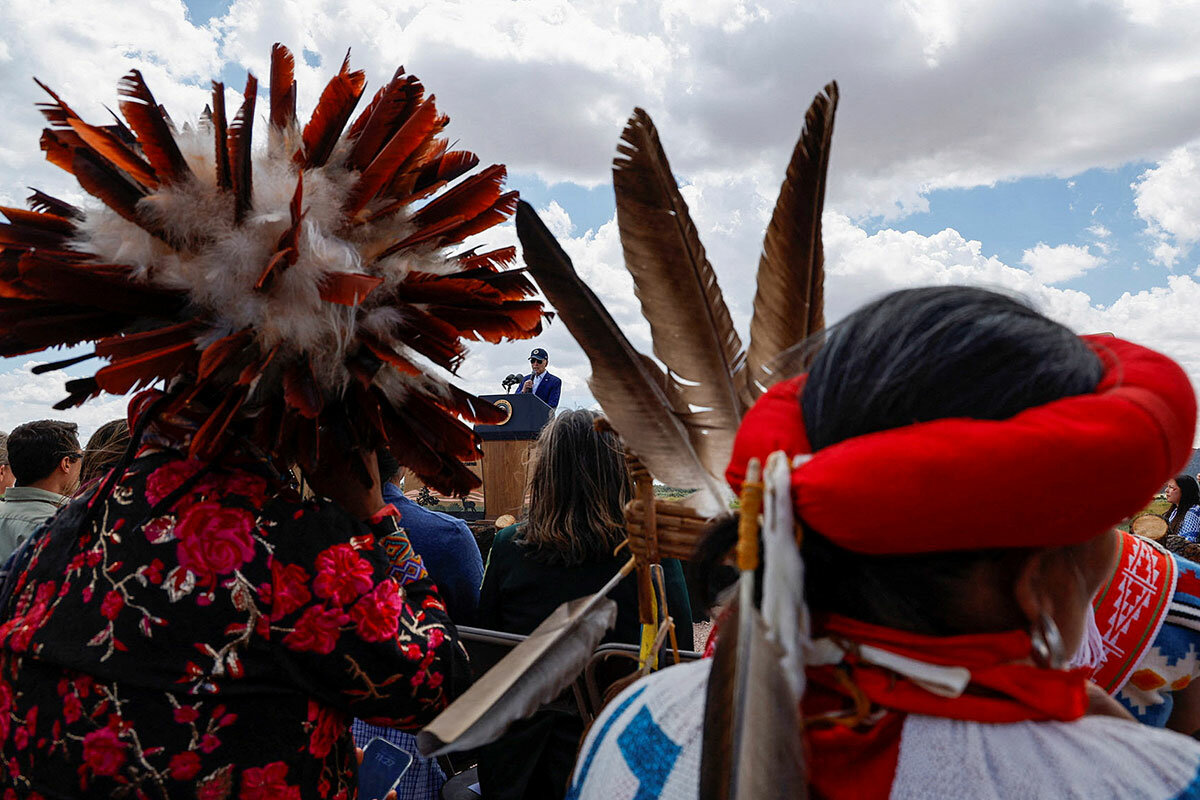
A look ahead
Thanks for joining us today. We’ll be back tomorrow with a look at what’s at stake in the fallout from a military coup in Niger.


